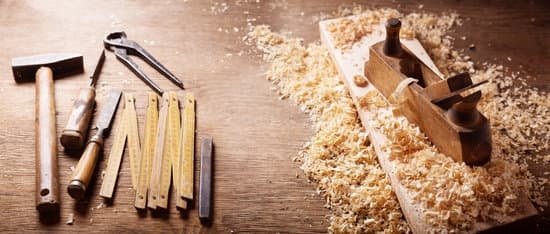Dowels are essential components in woodworking, often used to reinforce joints and add structural support to various projects. One common question among woodworkers is “how many dowels to use in woodworking?” Understanding the importance of using the right number of dowels is crucial for the success and longevity of any woodworking project.
In this article, we will explore the various types and sizes of dowels commonly used in woodworking, as well as the significance of using the correct number of dowels for different projects. Factors that should be considered when determining the appropriate number of dowels will also be discussed, providing a comprehensive understanding for woodworkers at any skill level.
Additionally, we will provide a step-by-step guide on calculating the number of dowels needed for specific woodworking projects, along with tips and tricks for properly spacing and placing them. By avoiding common mistakes and learning from real-life examples of successful woodworking projects, you can ensure that your own endeavors are bolstered by the right amount of dowels. So, let’s dive into this comprehensive guide on how to effectively utilize dowels in woodworking.
Types and Sizes of Dowels Commonly Used in Woodworking
In woodworking, dowels are used to reinforce joints, provide support, and add decorative touches to projects. They come in various types and sizes, each suited for different purposes. Common types of dowels used in woodworking include fluted dowels, spiral grooved dowels, and multi-groove dowels. Additionally, they are available in different sizes, ranging from as small as 1/4 inch to as large as 1 inch in diameter.
Fluted dowels are the most common type used in woodworking and are typically made from birch wood. They have spiral flutes along their length, which helps distribute glue evenly when inserted into a hole. Spiral grooved dowels have deep spirals that allow excess glue to escape when inserted into a hole. Multi-groove dowels, on the other hand, have multiple circumferential grooves that grip onto the sides of the hole for added strength.
When determining how many dowels to use for a woodworking project, it is crucial to consider the type and size of the wood being joined, as well as the weight and stress the joint will endure. For example, heavier or load-bearing structures will require more dowel reinforcement than lighter applications.
It’s essential to calculate not only how many dowels are needed but also their spacing and placement for optimal support. Understanding these factors will help ensure proper joint strength and durability.
Overall, understanding the types and sizes of dowels commonly used in woodworking is essential for choosing the right ones for your project. By considering factors such as wood type, joint stress, and proper calculations on how many dowels to use woodworking projects can be enhanced with strong and reliable connections.
Importance of Using the Right Number of Dowels in Woodworking Projects
Benefits of Using the Right Number of Dowels
Using the correct number of dowels in woodworking projects is crucial for ensuring the structural integrity and strength of the finished product. When the correct number of dowels are used, they provide strong reinforcement at joints and connections, preventing them from loosening or weakening over time.
This results in a more durable and long-lasting piece of furniture or structure. Additionally, using the right number of dowels helps to evenly distribute stress and weight across the entire piece, reducing the risk of breakage or failure.
Consequences of Using Too Few or Too Many Dowels
If too few dowels are used in a woodworking project, it can lead to weak joints and instability in the final product. This increases the likelihood of joints coming apart under stress, leading to potential safety hazards and premature damage to the piece.
On the other hand, using too many dowels can weaken the surrounding wood and compromise its integrity. This can result in a project that is more prone to splitting or cracking along the line of excessive dowel holes.
Calculating the Right Number of Dowels
To determine how many dowels to use in a woodworking project, it is important to consider factors such as the type and size of wood being used, as well as the specific load-bearing requirements of the project. Calculating spacing for dowel placement is also important, as this will impact how many dowels are needed.
Additionally, understanding different joinery techniques and their respective strength properties can help determine how many dowels should be used at specific joint locations. Taking these factors into account will ensure that you use an appropriate number of dowels for your woodworking project, ultimately leading to a successful outcome.
Factors to Consider When Determining the Number of Dowels to Use
When determining the number of dowels to use in woodworking projects, there are several factors that need to be taken into consideration. Properly assessing these factors will ensure that you use the right amount of dowels for your project, resulting in a sturdy and professional finish. Here are some key factors to consider:
- Size and weight of the project: Larger and heavier woodworking projects will require more dowels for structural support. Consider how much weight the joint will need to bear and choose the appropriate number of dowels accordingly.
- Wood type and density: Different types of wood have varying densities, which can affect how the wood will hold together. Hardwoods may require more dowels compared to softer woods. Take into account the type of wood you are working with when determining the number of dowels needed.
- Stress on the joint: Consider the amount of stress or force that will be applied to the joint once the project is complete. For example, a table leg that will bear a heavy load will require more dowels compared to a decorative cabinet door.
Understanding and carefully evaluating these factors will help you determine how many dowels to use in your woodworking projects, ensuring each joint is strong and durable.
In addition to these factors, it’s also important to consider the spacing between each dowel. Properly spacing and placing dowels is essential for achieving good results in woodworking projects. The distance between each dowel can impact the overall strength and stability of the joint. It’s essential to follow a recommended guide for spacing between dowels based on their size and placement within your project.
By taking these factors into account, you can avoid common mistakes such as using too few or too many dowels in your woodworking projects, ultimately leading to successful and long-lasting results.
Step-by-Step Guide on Calculating the Number of Dowels Needed for a Woodworking Project
When it comes to woodworking, the use of dowels is essential for creating strong and sturdy joints in wood projects. However, determining the right number of dowels to use can be a crucial factor in the success of your project.
Using too few dowels may result in weak joints that are prone to failure, while using too many dowels can lead to unnecessary expenses and structural issues. This step-by-step guide will help you calculate the appropriate number of dowels needed for your woodworking project.
- Step 1: Determine the size and type of wood you are working with. Different types and sizes of wood will require varying amounts of support from dowels.
- Step 2: Consider the weight and stress that will be placed on the joint. Heavier loads or constant movement will require additional reinforcement from dowels.
- Step 3: Calculate the length of each joint that requires doweling. Longer joints may need more dowels to distribute weight and stress effectively.
- Step 4: Decide on the spacing between each dowel. The general rule is that closer spacing between dowels results in stronger joints, but this may vary depending on the specific project.
By following these steps and carefully considering all relevant factors, you can accurately determine how many dowels to use for your woodworking project. This process ensures that your joints are strong, durable, and able to withstand the demands placed upon them. Taking the time to calculate the right number of dowels will ultimately lead to a successful and long-lasting woodworking creation.
Tips
• When in doubt, it’s always better to err on the side of caution and use more dowels rather than less.
• Consult with experienced woodworkers or professionals for specific guidance on calculating the number of dowels needed for your particular project.
• Practice proper measuring techniques and take accurate measurements to ensure precision in determining the required number of dowels.
Remember, getting the right number of dowels is crucial for a successful woodworking project, so take your time and carefully consider all relevant factors before proceeding with your construction efforts.
Tips and Tricks for Properly Spacing and Placing Dowels in Woodworking
Consider the Size and Weight of the Project
When deciding on how many dowels to use in a woodworking project, it’s important to consider the size and weight of the project. Larger and heavier projects will require more dowels to provide adequate support and stability. For example, a large bookshelf or table may need additional dowels compared to a smaller picture frame.
Use the Right Tools for Precise Placement
To ensure that the dowels are properly spaced and placed in your woodworking project, it’s crucial to use the right tools. A doweling jig can help you accurately drill holes for the dowels, ensuring that they are evenly spaced and aligned. Additionally, using a depth stop on your drill will help you achieve consistent hole depths for the dowels.
Pay Attention to Wood Grain Direction
When placing dowels in woodworking projects, it’s important to consider the direction of the wood grain. Aligning the wood grain of the dowel with that of the wood pieces being joined can enhance the overall strength and stability of the joint. This attention to detail can make a significant difference in how well your woodworking project holds up over time.
By taking these tips and tricks into consideration when spacing and placing dowels in your woodworking projects, you can ensure that your joints are strong, stable, and long-lasting. Paying attention to factors such as project size, tool selection, and wood grain direction will ultimately result in a successful woodworking endeavor.
Common Mistakes to Avoid When Using Dowels in Woodworking
When it comes to using dowels in woodworking, there are some common mistakes that beginners and even experienced woodworkers can make. One of the most common mistakes is using the wrong number of dowels for a project. Determining how many dowels to use in a woodworking project is crucial, and using too few or too many can result in a weak or uneven joint.
Another mistake to avoid is not considering the size and type of wood when determining the number of dowels to use. Different types of wood and different sizes of wood pieces will require varying numbers of dowels to ensure a strong and secure bond. Furthermore, failing to properly space and place the dowels can also lead to structural issues in the final woodworking project.
It’s important for woodworkers to take into account all these factors when deciding on the number of dowels needed for their project. By following a systematic approach and considering the type and size of wood, as well as proper spacing and placement, woodworkers can avoid these common mistakes and achieve better results in their woodworking projects.
| Woodworking Mistakes | Consequences |
|---|---|
| Using wrong number of dowels | Weakened or uneven joints |
| Not considering wood type/size | Weak or insecure bond |
| Improper spacing/placement | Structural issues in final project |
Real-Life Examples of Woodworking Projects and the Appropriate Number of Dowels Used
When it comes to woodworking projects, the number of dowels used can make a significant impact on the overall strength and stability of the final piece. Let’s take a look at a few real-life examples to understand how the appropriate number of dowels can be determined and utilized in different woodworking projects.
One common example is the construction of a wooden chair. Chairs are subject to a lot of stress and weight, so it’s crucial to use the right number of dowels to ensure that the joints are strong and durable. In this case, factors such as the type of wood being used, the weight capacity of the chair, and the design all play a role in determining how many dowels should be used for each joint.
Another example is building a wooden bookshelf. The shelves need to support the weight of books and other items, so using an appropriate number of dowels is essential for ensuring that the structure remains sturdy over time. Factors like shelf spacing, wood type, and anticipated load all need to be considered when calculating how many dowels to use in this type of project.
A final example could be creating a wooden table with intricate designs. Depending on the complexity of the design, it’s important to strategically place an adequate number of dowels to ensure that all parts are appropriately connected without compromising aesthetics or structural integrity. The type of joinery methods used will also influence how many dowels need to be incorporated into this kind 0f woodworking project.
Conclusion
In conclusion, the number of dowels used in woodworking projects plays a crucial role in ensuring the strength and stability of the final product. Using too few dowels can result in weak joints and potential structural issues, while using too many dowels can lead to overcrowding and weakening of the wood.
It is essential to carefully consider the factors that determine the appropriate number of dowels for each specific project, such as the type and size of wood, intended use of the item, and overall design.
When determining how many dowels to use in woodworking, it is important to remember that there is no one-size-fits-all answer. Each project will have its unique requirements, and careful calculation and consideration are necessary to ensure a successful outcome. By following a step-by-step guide for calculating the number of dowels needed for a woodworking project, woodworkers can achieve strong, durable joints that contribute to the overall quality and longevity of their creations.
In essence, getting the right number of dowels for woodworking projects requires attention to detail, proper planning, and a clear understanding of how different factors influence joint strength. By taking into account the guidance provided in this article and learning from real-life examples of successful woodworking projects, woodworkers can improve their skills in utilizing dowels effectively to create high-quality pieces that stand the test of time.
Frequently Asked Questions
How Many Dowels Should You Use?
The number of dowels you should use depends on the size and weight of the objects you are joining. As a general rule, it’s best to use more dowels for larger or heavier pieces to ensure stability.
What Is the Rule for Dowels?
The rule for dowels is to place them evenly spaced along the joint, with closer spacing for larger or heavier items. Typically, dowels are placed about 6-12 inches apart, but this can vary based on the specific project and materials being used.
How Far Apart Should I Space Dowels?
When spacing dowels, it’s important to consider the size and weight of the materials you are joining. For smaller or lighter items, you can space the dowels further apart, while larger or heavier pieces may require closer spacing to provide adequate support. Always follow any specific guidelines or recommendations provided for your particular project.

Hi everyone! I’m a woodworker and blogger, and this is my woodworking blog. In my blog, I share tips and tricks for woodworkers of all skill levels, as well as project ideas that you can try yourself.





